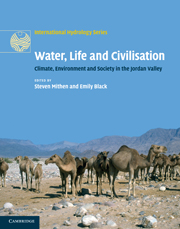Book contents
- Frontmatter
- Contents
- List of figures
- List of tables
- List of contributors
- Acknowledgements
- 1 Introduction: an interdisciplinary approach to Water, Life and Civilisation
- Part I Past, present and future climate
- Part II The palaeoenvironmental record
- Part III Hydrological studies of the Jordan Valley
- 10 The impacts of climate change on rainfall-runoff in the upper River Jordan: methodology and first projections
- 11 Modelling Dead Sea levels and rainfall: past, present and future
- 12 The hydrology of the Wadi Faynan
- 13 Future projections of water availability in a semi-arid region of the eastern Mediterranean: a case study of Wadi Hasa, Jordan
- Part IV Human settlement, climate change, hydrology and water management
- Part V Palaeoeconomies and developing archaeological methodologies
- Part VI Society, economy and water today
- Part VII Conclusions
- Index
- Plate section
- References
11 - Modelling Dead Sea levels and rainfall: past, present and future
from Part III - Hydrological studies of the Jordan Valley
Published online by Cambridge University Press: 26 April 2011
- Frontmatter
- Contents
- List of figures
- List of tables
- List of contributors
- Acknowledgements
- 1 Introduction: an interdisciplinary approach to Water, Life and Civilisation
- Part I Past, present and future climate
- Part II The palaeoenvironmental record
- Part III Hydrological studies of the Jordan Valley
- 10 The impacts of climate change on rainfall-runoff in the upper River Jordan: methodology and first projections
- 11 Modelling Dead Sea levels and rainfall: past, present and future
- 12 The hydrology of the Wadi Faynan
- 13 Future projections of water availability in a semi-arid region of the eastern Mediterranean: a case study of Wadi Hasa, Jordan
- Part IV Human settlement, climate change, hydrology and water management
- Part V Palaeoeconomies and developing archaeological methodologies
- Part VI Society, economy and water today
- Part VII Conclusions
- Index
- Plate section
- References
Summary
ABSTRACT
The Dead Sea has played a crucial role in the past development of communities in the Jordan Valley, as evidenced by the wide range of archaeological sites close to the sea or potential old sea shorelines. There is also considerable debate concerning how levels have changed over the recent past and also how water resources in the Jordan Valley will be managed in the future. Over the past 50 years there has been a significant reduction in the level of the Dead Sea driven by abstractions from the Jordan River, the main source of fresh water to the sea. Falling levels have created problems for the tourism industry, and there are plans to restore levels using a water transfer from the Red Sea or the Mediterranean to the Dead Sea. A new model of the Dead Sea levels is described, based on historical rainfall and level data from 1860 to 1960. The model is used to simulate the impacts of abstractions on Dead Sea levels that have resulted in a 45-m reduction in levels since the 1960s. The model is also used to evaluate the impacts of future climate change: it is shown that the projected changes in rainfall have a far smaller impact on Dead Sea levels than do the abstractions. The model also shows that the only way to avoid this problem is to transfer water into the Dead Sea from either the Red Sea or the Mediterranean. […]
- Type
- Chapter
- Information
- Water, Life and CivilisationClimate, Environment and Society in the Jordan Valley, pp. 147 - 156Publisher: Cambridge University PressPrint publication year: 2011



